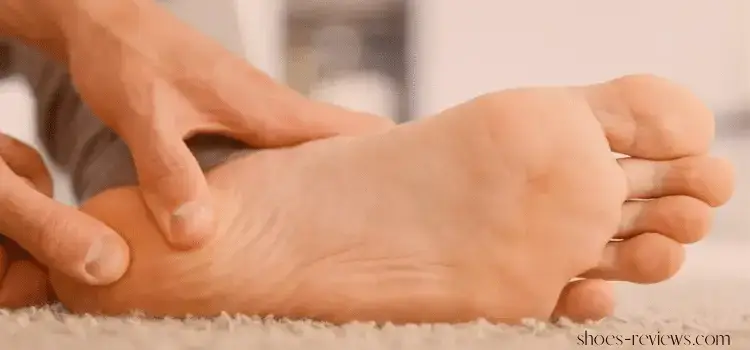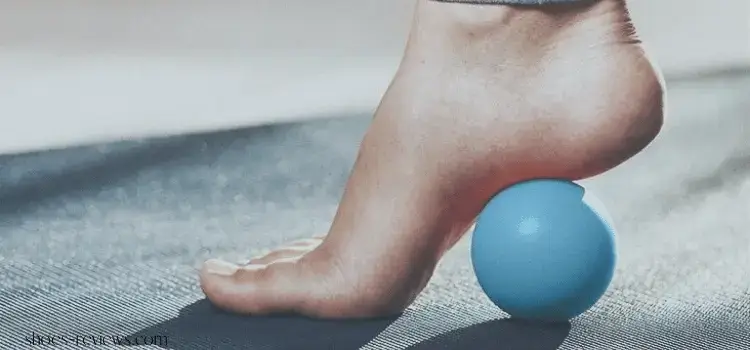Are you tired of living in constant discomfort due to plantar fasciitis? Well, it’s time to kick off. Those traditional shoes make way for a revolution in footwear – barefoot shoes! Yes, you heard that right.
As we mentioned: Do barefoot shoes help plantar fasciitis? The brief is Sockless shoes that are barefoot. These shoes are made of leather or other pleasant materials. These shoes improve foot health. Barefoot shoes feel best.
In this blog post, we dive deep into the world of barefoot. Shoes and their potential to ease the unbearable pain caused by plantar fasciitis.
The Meaning Of Plantar Fasciitis And How It Affects People

Plantar fasciitis hurts and makes the heel stiff. From the heel to the ball of the foot, the plantar fascia is a ring of muscle. It softens steps and supports the foot arch. Stress or swelling can lead to heel pain. Plantar pain is joint in runners and people. Working in the food industry.
It can also be caused by being overweight or having tight Achilles tendons. Wearing shoes that don’t give you enough support. Plantar pain can be treated in many ways. Rest, ice, and over-the-counter drugs help ease discomfort. Stretching and strengthening the foot muscles may also be suggested.
A unique replacement device or surgery might be needed. In recent years, barefoot shoes have become more familiar to avoid plantar fasciitis. Even though there is no solid proof, many people find that barefoot shoes help them. Avoid pain, a sore heel, and other plantar fasciitis signs.
Traditional Shoes And Barefoot Shoes
There are two schools of thought on shoes and heel pain. Some people like regular shoes with arch support and padding. While others want barefoot shoes, Heel fasciitis users need clear shoe advice.
One person’s best may not work for another. Some people with heel fasciitis prefer barefoot shoes, while others prefer regular shoes. Both barefoot shoes and daily shoes have pros and cons. Even though classic shoes provide better support and safety, they are uncomfortable and tight.
Your feet can move quickly in barefoot shoes, which don’t support or protect them. Try on a lot of different styles to find the right shoe. If you have heel pain, try both traditional shoes and barefoot shoes.
Plantar Fasciitis Can Be Helped By Wearing Barefoot Shoes
When you have plantar fasciitis, barefoot shoes can help in many ways, when you wear barefoot shoes. Your feet can move more efficiently, which is better for your feet and joints. Also, barefoot shoes can help you better stand and keep your balance. Making your feet feel better.
Also, going barefoot can help your feet and knees get stronger. Making it less likely that you’ll get more heel pain. And barefoot shoes can help reduce the swelling in the feet and joints that plantar fasciitis can cause.
Lastly, shoes made for bare feet can help handle shock better. Getting heel fasciitis to hurt and bother you less.
Possible Risks of Wearing Barefoot Shoes with Plantar Fasciitis
There are a few things to watch out for if you have heel fasciitis and wear barefoot shoes. One reason is that they need the support of regular shoes. The plantar fascia may be stretched and hurt even more.
Also, the foot arch might drop more, hurting the heel and joints. More because shoes for bare feet don’t have much padding. They might not keep people with heel fasciitis from coming into touch with enough things.
If you wear barefoot shoes, you must pay attention to your body and stop if it hurts.
Types Of Barefoot Shoes Available
Different barefoot shoes support and protect your feet differently. Here are some popular barefoot shoes:
Minimalist Shoes
Minimalist shoes are those that offer the least amount of support and safety for your feet. Most of the time, they are very light and easy to bend, so your feet have room to move. People with heel fasciitis want shoes that won’t make the pain worse. Shoes with few features are a good choice.
Barefoot Running Shoes
These shoes make it feel like you’re going barefoot. But they still keep your feet safe and help you stand. Most barefoot running shoes have thin soles and no support for the arch.
Makes it easier to move your feet. But some people with heel fasciitis might not be able to wear these shoes. They can make things worse.
Sandals
Sandals are a good choice for those with heel pain. Who wants to look after themselves? Their feet from getting hurt more while letting them rest and air out.
Sandals generally have straps that go around the ankle or the leg. These straps help to support the foot and keep it from moving too much.
What To Look For When Choosing A Pair Of Barefoot Shoes
Keep a few things in mind when choosing barefoot shoes to help with heel pain. First, look for shoes that give your toes a lot of space. It will let your toes spread out and grip the ground, which can help take pressure off the plantar fascia.
Second, choose a shoe that gives your hip good support. That will keep the arch of your foot from falling, which can put pressure on the plantar muscle. Make sure there is padding on the bottom of the shoe. It will help your heel handle the load and keep it from getting hurt.
Other Tips for Wearing Barefoot Shoes with Plantar Fasciitis
You can do a few other things to help make barefoot shoes work better for plantar fasciitis.
- First, make sure you’re wearing the correct size shoe. Barefoot shoes should fit snugly and not be too loose.
- Second, wear socks made of moisture-wicking material to help keep your feet dry.
- Third, avoid walking on hard surfaces as much as possible. Stick to softer surfaces like grass or sand.
- Finally, gradually increase the time you spend wearing barefoot shoes daily. Start with just a few minutes and then slowly increase the time as your feet get used to it.
Research Studies On Barefoot Shoes And Plantar Fasciitis
People have different ideas about whether barefoot shoes help heal fasciitis. Some tests have shown that barefoot shoes can help with pain in the short term. But there isn’t much evidence that barefoot shoes are suitable for long-term heel pain.
After eight weeks, one study found that. People who wore shoes without support were in much less pain than those with help. In a different research, running without shoes was tied to a lower risk of heel fasciitis. But not all studies have found that barefoot shoes are suitable for heel fasciitis.
One study found that the results were the same whether people wore shoes or not. The study on barefoot shoes and heel pain needs to be more accurate. If you have heel pain and want to try barefoot shoes, you should talk to your doctor first.
Exercises And Stretches For Plantar Fasciitis Relief

If you’ve ever had heel fasciitis, you know how painful it can be. Some stretches and movements can help ease the pain. The “toe raise” is a beneficial exercise. To do this exercise, stand on your toes for a few seconds and then lean back.
Do this 10 to 15 times. Another great workout is the “heel walk.” To do this, spend a few minutes walking on your feet daily. It will help stretch out the plantar muscle and relieve pain. Besides activities, stretching can help people with heel fasciitis.
Sit in a chair and wrap a towel around your foot to do one stretch. Pull the towel toward you with your hand, but keep your heel on the ground. Does this stretch a few times a day for 30 seconds each time? Try these routines, and hurts if you have heel fasciitis.
Testimonials From Barefoot Shoe Wearers With Plantar Fasciitis
When people have heel fasciitis, barefoot shoes help a lot of them. Shoes that don’t completely cover the foot let the foot move. Lessening the strain on the plantar muscles and stopping more crashes from happening. Choosing barefoot shoes that are soft and give you support is essential.
Shoes should fit well and not bother or hurt the feet. Plantar pain affects some people. Before their symptoms get better, they must go barefoot for weeks or months.
But when they don’t wear shoes, many people feel better, and their symptoms improve. Talk to your doctor or an expert before you try barefoot shoes to ease plantar fasciitis pain.
Other Natural Remedies For Plantar Fasciitis
There are numerous additional natural treatments for plantar fasciitis; some find these work better than barefoot shoes. Among the most prevalent natural remedies are the following:
- Icing the affected area for 10-15 minutes several times a day
- massaging the foot with a tennis ball or frozen water bottle
- stretching the calf muscles and Achilles tendon
- taking over-the-counter anti-inflammatory medication such as Ibuprofen
If you are struggling with plantar fasciitis, Consultation with a medical expert is essential to determining which treatment option is best for you.
Conclusion
Plantar pain and barefoot shoes: things to think about. The foot can stretch and get stronger when you wear barefoot shoes. Muscles and joints, easing the pain of heel fasciitis. But barefoot shoes may make heel pain that is already bad worse. See your doctor before you buy barefoot shoes.
FAQs
What Shoes Should I Avoid With Plantar Fasciitis?
People with plantar fasciitis should not wear specific shoes. Plantar fasciitis can worsen when you wear shoes with tiny toes or high heels. Plantar fasciitis can worsen when you wear shoes with a lot of support or padding. Ask a doctor or someone specializing in feet what shoes would be best for you.
What Stops Plantar Fasciitis?
When you have plantar fasciitis, the fascia, which runs from the heel to the tips of your toes, gets red and swollen. It’s caused by dancing and running. It could be caused by shoes that don’t give enough support. There are many ways to treat and stop heel pain. When you rest, inflammation heals. Pain and swelling can be eased with Ibuprofen and 20-minute foot freezes.
Can Plantar Fasciitis Be Cured Naturally?
Plantar fasciitis can make your heel and foot hurt. It’s caused by overuse or repeated use. Barefoot shoes make your feet work better and make you feel better. There is no fix for plantar pain. But treatments can make the foot less painful and help it work better. Plantar fasciitis may get better if you wear barefoot shoes.